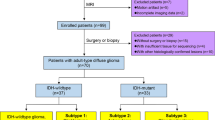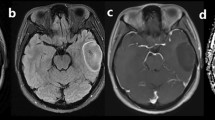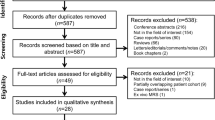Abstract
Introduction
The longitudinal relaxation time in the rotating frame (T1ρ) has proved to be sensitive to metabolism and useful in application to neurodegenerative diseases. However, few literature exists on its utility in gliomas. Thus, this study was conducted to explore the performance of T1ρ mapping in tumor grading and characterization of isocitrate dehydrogenase 1 (IDH1) gene mutation status of gliomas.
Methods
Fifty-seven patients with gliomas underwent brain MRI and quantitative measurements of T1ρ and apparent diffusion coefficient (ADC) were recorded. Parameters were compared between high-grade gliomas (HGG) and low-grade gliomas (LGG) and between IDH1 mutant and wildtype groups.
Results
HGG showed significantly higher T1ρ values in both the solid and peritumoral edema areas compared with LGG (P < 0.001 and P = 0.005, respectively), whereas no significant differences in the two areas were found for ADC (both P > 0.05). Receiver operating characteristic (ROC) curve analysis showed that T1ρ value in the solid area achieved the highest area under the ROC curve (AUC, 0.841) in grading with a sensitivity of 80.6% and a specificity of 81.0%. In the grade II/III glioma group, multivariate logistic regression showed that both tumor frontal lobe location (odds ratio [OR] 526.608; P = 0.045) and T1ρ value of the peritumoral edema area (OR 0.863; P = 0.037) were significant predictors of IDH1 mutation. Using the combination, the diagnostic sensitivity and specificity for IDH1 mutated gliomas were 93.3% and 88.9%, respectively.
Conclusions
Our study shows the feasibility of applying T1ρ mapping in assessing the histologic grade and IDH1 mutation status of gliomas.


Similar content being viewed by others
Abbreviations
- WHO:
-
World Health Organization
- LGG:
-
Low-grade glioma
- HGG:
-
High-grade glioma
- IDH1:
-
Isocitrate dehydrogenase 1
- MRI:
-
Magnetic resonance imaging
- DWI:
-
Diffusion-weighted imaging
- ADC:
-
Apparent diffusion coefficient
- T1ρ:
-
Longitudinal relaxation time in the rotating frame
- FLAIR:
-
Fluid-attenuated inversion recovery
- TR:
-
Repetition time
- TE:
-
Echo time
- FOV:
-
Field of view
- SLT:
-
Spin lock time
- ROI:
-
Region of interest
- NAWM:
-
Normal-appearing white matter
- ICC:
-
Intraclass correlation coefficient
- ROC:
-
Receiver operating characteristic
- AUC:
-
Area under the curve
References
Louis DN, Perry A, Reifenberger G et al (2016) The 2016 World Health Organization classification of tumors of the central nervous system: a summary. Acta Neuropathol 131:803–820
Park JE, Kim HS, Park KJ, Choi CG, Kim SJ (2015) Histogram analysis of amide proton transfer imaging to identify contrast-enhancing low-grade brain tumor that mimics high-grade tumor: increased accuracy of MR perfusion. Radiology 277:151–161
Stupp R, Mason WP, Mj VDB et al (2005) Radiotherapy plus concomitant and adjuvant temozolomide for glioblastoma. N Engl J Med 352:987–996
Sanai N, Berger MS (2008) Glioma extent of resection and its impact on patient outcome. Neurosurgery 62:264–266
Beiko J, Suki D, Hess KR et al (2014) IDH1 mutant malignant astrocytomas are more amenable to surgical resection and have a survival benefit associated with maximal surgical resection. Neuro-oncology 16:81–91
Yan H, Parsons DW, Jin G et al (2009) IDH1 and IDH2 mutations in gliomas. N Engl J Med 360:765–773
Kono K, Inoue Y, Nakayama K et al (2001) The role of diffusion-weighted imaging in patients with brain tumors. AJNR Am J Neuroradiol 22:1081–1088
Kang Y, Choi SH, Kim Y-J et al (2011) Gliomas: histogram analysis of apparent diffusion coefficient maps with standard- or high-b-value diffusion-weighted MR imaging—correlation with tumor grade. Radiology 261:882–890
Fan GG, Deng QL, Wu ZH, Guo QY (2006) Usefulness of diffusion/perfusion-weighted MRI in patients with non-enhancing supratentorial brain gliomas: a valuable tool to predict tumour grading? Br J Radiol 79:652–658
Lam WW, Poon WS, Metreweli C (2002) Diffusion MR imaging in glioma: does it have any role in the pre-operation determination of grading of glioma? Clin Radiol 57:219–225
Fuente MIDL, Young RJ, Rubel J et al (2015) Integration of 2-hydroxyglutarate-proton magnetic resonance spectroscopy into clinical practice for disease monitoring in isocitrate dehydrogenase-mutant glioma. Neuro-oncology 18:283–290
Duvvuri U, Kudchodkar S, Reddy R, Leigh JS (2002) T 1ρ relaxation can assess longitudinal proteoglycan loss from articular cartilage in vitro. Osteoarthr Cartil 10:838–844
Regatte RR, Akella SV, Borthakur A, Reddy R (2003) Proton spin-lock ratio imaging for quantitation of glycosaminoglycans in articular cartilage. J Magn Reson Imaging 17:114–121
Wang YX, Yuan J, Chu ES et al (2011) T_(1ρ) MR imaging is sensitive to evaluate liver fibrosis: an experimental study in a rat biliary duct ligation model. Radiology 259:712–719
Haris M, Mcardle E, Fenty M et al (2009) Early marker for Alzheimer’s disease: hippocampus T1rho (T1ρ) estimation. J Magn Reson Imaging 29:1008–1012
Sierra A, Michaeli S, Niskanen JP et al (2008) Water spin dynamics during apoptotic cell death in glioma gene therapy probed by T1rho and T2rho. Magn Reson Med 59:1311–1319
Villanueva-Meyer J, Barajas R, Mabray M et al (2017) Differentiation of brain tumor-related edema based on 3D T1rho imaging. Eur J Radiol 91:88–92
Barajas RF Jr, Villanueva-Meyer J, Perry A, Berger M, Cha S (2017) Biologically aggressive regions within glioblastoma identified by spin-lock contrast T1 relaxation in the rotating frame (T1rho) MRI. Radiol Case Rep 12:827–832
Johnson CP, Heo HY, Thedens DR, Wemmie JA, Magnotta VA (2014) Rapid acquisition strategy for functional T1ρ mapping of the brain. Magn Reson Imaging 32:1067–1077
Heo HY, Wemmie JA, Johnson CP, Thedens DR, Magnotta VA (2015) Eccentricity mapping of the human visual cortex to evaluate temporal dynamics of functional T1rho mapping. J Cereb Blood Flow Metab 35:1213–1219
Serverabcdea A (2011) Measurements of diagnostic examination performance using quantitative apparent diffusion coefficient and proton MR spectroscopic imaging in the preoperative evaluation of tumor grade in cerebral gliomas. Eur J Radiol 80:462–470
Choi HS, Kim AH, Ahn SS, Shin NY, Kim J, Lee SK (2013) Glioma grading capability: comparisons among parameters from dynamic contrast-enhanced MRI and ADC value on DWI. Korean J Radiol 14:487–492
DeLong ER, DeLong DM, Clarke-Pearson DL (1988) Comparing the areas under two or more correlated receiver operating characteristic curves: a nonparametric approach. Biometrics 44:837–845
Mangia S, Carpenter AF, Tyan AE, Eberly LE, Garwood M, Michaeli S (2014) Magnetization transfer and adiabatic T1rho MRI reveal abnormalities in normal-appearing white matter of subjects with multiple sclerosis. Mult Scler 20:1066–1073
Magnotta VA, Heo HY, Dlouhy BJ et al (2012) Detecting activity-evoked pH changes in human brain. Proc Natl Acad Sci USA 109:8270–8273
Poptani H, Duvvuri U, Miller CG et al (2001) T1 ρ Imaging of murine brain tumors at 4 T. Acad Radiol 8:42–47
Watts R, Andrews T, Hipko S, Gonyea JV, Filippi CG (2014) In vivo whole-brain T1-rho mapping across adulthood: normative values and age dependence. J Magn Reson Imaging 40:376–382
Mou K, Chen M, Mao Q et al (2010) AQP-4 in peritumoral edematous tissue is correlated with the degree of glioma and with expression of VEGF and HIF-alpha. J Neuro-oncol 100:375–383
Howe FA, Barton SJ, Cudlip SA et al (2003) Metabolic profiles of human brain tumors using quantitative in vivo 1H magnetic resonance spectroscopy. Magn Reson Med 49:223–232
Bai Y, Lin Y, Tian J et al (2016) Grading of gliomas by using monoexponential, biexponential, and stretched exponential diffusion-weighted MR imaging and diffusion kurtosis MR imaging. Radiology 278:496–504
Suh CH, Kim HS, Jung SC, Choi CG, Kim SJ (2018) Imaging prediction of isocitrate dehydrogenase (IDH) mutation in patients with glioma: a systemic review and meta-analysis. Eur Radiol. https://doi.org/10.1007/s00330-018-5608-7 (Epub ahead of print)
Waitkus MS, Diplas BH, Yan H (2016) Isocitrate dehydrogenase mutations in gliomas. Neuro-Oncology 18:16–26
Ohka F, Ito M, Ranjit M et al (2014) Quantitative metabolome analysis profiles activation of glutaminolysis in glioma with IDH1 mutation. Tumour Biol 35:5911–5920
Sasaki M, Knobbe CB, Itsumi M et al (2012) D-2-hydroxyglutarate produced by mutant IDH1 perturbs collagen maturation and basement membrane function. Gene Dev 26:2038–2049
Kickingereder P, Sahm F, Radbruch A et al (2015) IDH mutation status is associated with a distinct hypoxia/angiogenesis transcriptome signature which is non-invasively predictable with rCBV imaging in human glioma. Sci Rep 5:16238
Kettunen MI, Grohn OH, Silvennoinen MJ, Penttonen M, Kauppinen RA (2002) Effects of intracellular pH, blood, and tissue oxygen tension on T1rho relaxation in rat brain. Magn Reson Med 48:470–477
Acknowledgements
This study has received funding by National Natural Science Foundation of China (contract Grant Number: 81701642, 81571650, and 81501458); Shanghai Science and Technology Committee Medical Guide Project (western medicine) (contract Grant Number: 17411964300); and Medical Engineering Cross Research Foundation of Shanghai Jiao Tong University (contract Grant Number: YG2015QN37).
Author information
Authors and Affiliations
Corresponding author
Ethics declarations
Conflict of interest
J. Qu is employee of GE healthcare. The other authors declare that they have no conflict of interest.
Rights and permissions
About this article
Cite this article
Cao, M., Ding, W., Han, X. et al. Brain T1ρ mapping for grading and IDH1 gene mutation detection of gliomas: a preliminary study. J Neurooncol 141, 245–252 (2019). https://doi.org/10.1007/s11060-018-03033-7
Received:
Accepted:
Published:
Issue Date:
DOI: https://doi.org/10.1007/s11060-018-03033-7




